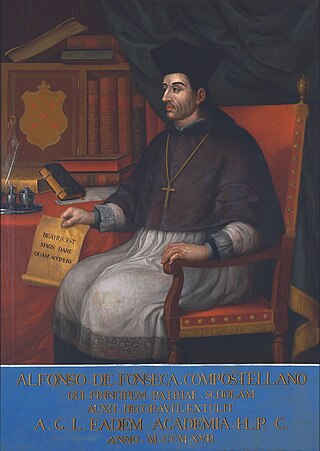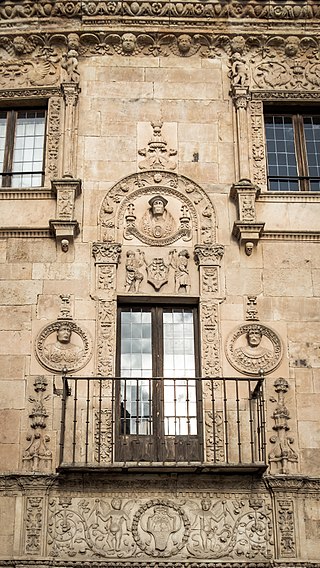The Compostela Group of Universities (CGU) is an international non-profit association that promotes and executes collaboration projects between institutions of higher education.

The University of Santiago de Compostela - USC is a public university located in the city of Santiago de Compostela, Galicia, Spain. A second campus is located in Lugo, Galicia. It is one of the world's oldest universities in continuous operation.

Plateresque, meaning "in the manner of a silversmith", was an artistic movement, especially architectural, developed in Spain and its territories, which appeared between the late Gothic and early Renaissance in the late 15th century, and spread over the next two centuries. It is a modification of Gothic spatial concepts and an eclectic blend of Mudéjar, Flamboyant Gothic and Lombard decorative components, as well as Renaissance elements of Tuscan origin.

Irish Colleges is the collective name used for approximately 34 centres of education for Irish Catholic clergy and lay people opened on continental Europe in the 16th, 17th and 18th centuries.

The Archdiocese of Santiago de Compostela is a Latin Church archdiocese of the Catholic Church in Spain. It is the senior of the five districts in which the church divides Galicia in North-western Spain.

Rodrigo Gil de Hontañón (1500–1577) was a Spanish architect of the Renaissance.

Spanish Renaissance architecture was that style of Renaissance architecture in the last decades of the 15th century. Renaissance evolved firstly in Florence and then Rome and other parts of the Italian Peninsula as the result of Renaissance humanism and a revived interest in Classical architecture. In Spain, the Renaissance began to be grafted to Gothic forms as mathematicians and engineers rediscovered building as one of the technological sciences. In the time of King Felipe II (1556–1589), the Renaissance influence expanded throughout the territory thanks to the dissemination of architectural treatises.
Bérenger de Landore (1262–1330) was a French Dominican, who became Master of the Order of Preachers (1312–1317), and then Archbishop of Santiago de Compostela (1317-1330). He was from a noble family of southern France.

Alonso III Fonseca was a Galician archbishop and politician. He was Archbishop of Santiago de Compostela from 1507, and Archbishop of Toledo from 1523. He was a major supporter of the University of Santiago de Compostela.

Salamanca is a municipality and city in Spain, capital of the province of the same name, located in the autonomous community of Castile and León. It is located in the Campo Charro comarca, in the Meseta Norte, in the northwestern quadrant of the Iberian Peninsula. It has a population of 144,436 registered inhabitants. Its stable functional area reaches 203,999 citizens, which makes it the second most populated in the autonomous community, after Valladolid. Salamanca is known for its large number of remarkable Plateresque-style buildings.

The San Clemente Dormitory is a public dormitory, depending on Universidad de Santiago de Compostela and located in the same city.

Purism is an initial phase of Renaissance architecture in Spain, which took place between 1530 and 1560, after Isabelline Gothic and prior to the Herrerian architecture in the last third of the 16th century. The name "Prince Philip" refers to the period in which Philip II of Spain had not yet received the inheritance of the Spanish Monarchy by abdication of his father, the Emperor Charles V (1556). The name "Serlian" is due to the influential architect and treatise Sebastiano Serlio.

Gaspar de Ávalos de la Cueva (1485–1545), also named Gaspar Dávalos de la Cueva, was a Spanish Roman Catholic bishop and cardinal.

The Irish College at Salamanca,, it was endowed by the King of Spain and dedicated as the St Patrick’s Royal College for Irish Noblemen. It was founded by Thomas White, formerly of Clonmel, Ireland, in 1592 to house the students of that country who came to Salamanca to escape the religious persecution of the Catholic Church in Ireland. The students resided at the college while attending lectures at the University of Salamanca.

Pico Sacro is a summit in the central Galician Massif and the municipality of Boqueixón. In antiquity it was known as Mount Ilicino, and features a hermitage, a cave, the remains of a medieval castle and a triangulation station. The mountain rises 530 meters (1,740 ft) and is known for its unique shape and a legend about the Apostle James. A deep and narrow cave sits just below the peak, and legend places a dragon there protecting one of the entrances to hell.

Alonso de Fonseca y Acevedo was a Roman Catholic prelate who served as Archbishop of Santiago de Compostela, and Archbishop of Seville (1465–1469).

Juan de Álava (1480-1537) was a Spanish architect best known for his stonework produced in the Plateresque style.

The Colegio Mayor de San Bartolomé, also formerly known as Colegio Mayor de Anaya or Colegio Viejo, is a colegio mayor attached to the University of Salamanca and located in Salamanca (Spain).

Alonso de Fonseca Square is a medieval square located in the historic centre of the city of Pontevedra (Spain), opposite the Basilica of Saint Mary Major.
The Irish College of San Jorge at Alcalá de Henares, was founded about 1648, from the estate of Baron George Sylveira, a Portuguese nobleman related to the McDonnells of Ulster through his mother. After the baron died, his widow Beatriz Silveira implemented his wishes and the College came into existence. Alcalá de Henares is a town to the northeast of Madrid, where the Complutense University was situated. The college and its chapel were dedicated to St. George, and were formally known as the Royal Irish College of St. George the Martyr, Alcala. Students would study for seven years in Theology and Arts, and the college was affiliated to the Complutense University of Madrid, aimed at training clerics for Ireland, Belgium(Flanders) and The Netherlands. The Irish Franciscan Luke Wadding, O.F.M. wrote the statutes for the college.

















